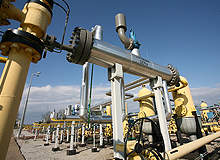
The Wierzchowice underground gas storage (UGS) facility, located in the Wroclaw province of Poland, is the largest storage facility in the country. It was converted from the partly depleted Wierzchowice natural gas reservoir to store high-methane gas.
The project was undertaken by state-owned Polish oil and gas company PGNiG. It is being executed in two phases with the first phase expected to be completed by the end of 2012. PGNiG received PLN116.6m from the Polish Crude Oil and Gas Institute in December 2010 to finance the first stage of the project. The second phase is expected to be completed by 2015.
The existing working volume of the facility is 0.575 billion cubic metres. Upon completion of the first phase in 2012, the capacity will increase to 1.2 billion cubic metres and after the second phase it will increase to 3.5 billion cubic metres. The maximum withdrawal rate of the facility is 4.8 million cubic metres a day.
Construction and infrastructure
The Wierzchowice reservoir contained low-methane gas and had undergone a long production period from 1972 to 1995. Before production was shut down, the reservoir’s infrastructure was modified for use as the Wierzchowice UGS facility.
A compressor station was already part of the production infrastructure at the reservoir. It was used for injection and withdrawal of gas. Using the existing infrastructure, the first stage of gas injection was started in April 1995. Plans to expand the capacity of the facility from 0.575 billion cubic metres to 1.2 billion cubic metres commenced in 2004.
Foundation stone of the surface infrastructure of the facility was laid in March 2009. These works are expected to be completed by November 2011.
Site
Poland is strategically located between Russia and western Europe and plays an important role in the European gas supply system. It maintains 18,000km of pipelines and six UGS facilities. Gas consumption in Poland is on the rise and UGS facilities play a key role in terms of offering security of supply and optimisation of distribution costs.
Most of Poland’s UGS facilities were created in depleted fields located in the Polish Lowland as they contain ideal levels of nitrogen and methane. This was essential as the UGS facilities stored high quality gas and the withdrawn gas was required to meet the pipeline gas standards of quality. High levels of nitrogen in the reservoirs would affect the quality of gas withdrawn due to its interaction with residual gas.
Simulation studies conducted to assess whether residual gas will affect the quality of injected gas revealed no such potential threats. The Wierzchowice UGS was feasible both technically and economically. The facility is also located near the Yamal-Europe gas pipeline facilitating delivery of gas.
Contractors
Gazprom carried out the feasibility study of the project.
A consortium comprising PBG, Tecnimont, Societe Francaise d’Etudes et de Realisations d’Equipements Gaziers SOFREGAZ, and Plynostav Pardubice Holding – Plynostav Regulace Plynu was awarded the general construction contract for the first phase of the project. The PLN1.3bn contract was awarded in November 2008.
Scope of work under the contract includes engineering, procurement, construction and commissioning of compressor units, heat exchanger units, fuel gas station and turboexpander unit. The contract also includes construction of inlet filters, combined cycle power plant, flow regulation and wells development units, fiscal metering units, electrical and control systems and other civil works.
The construction contract for the second phase is yet to be awarded.
In 2009, Contrast, a subsidiary of Atrem Group, won a PLN22m contract to provide power engineering works at the facility. Scope of work for Contrast included construction of a 110kV cable line and fibre optic line, switchboards and transformers.
Ateko supplied filter separator internals and quick-closing devices for the facility in October 2010.
SPIG was awarded a contract for supplying a multi-row technology air cooled condenser for the facility.

